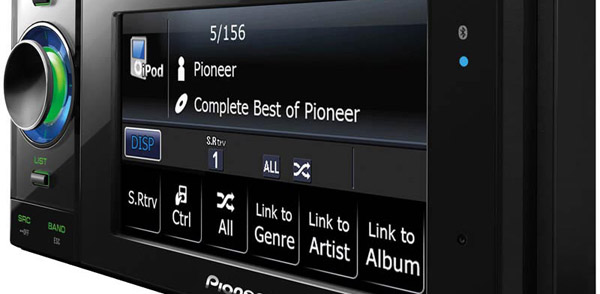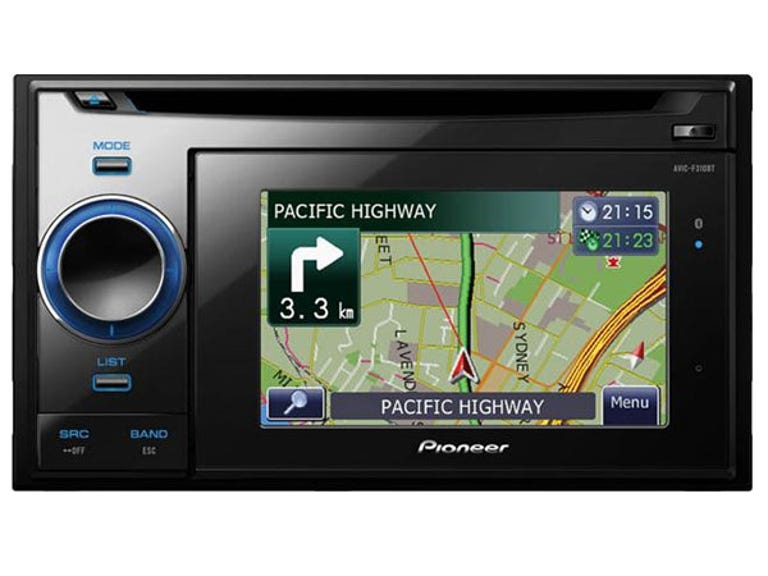 Why You Can Trust CNET
Why You Can Trust CNET Pioneer AVIC-F310BT review: Pioneer AVIC-F310BT
It's far from perfect (scary warnings, difficult controls, occasional glitches), but sound quality, Bluetooth, device support and its aggressive pricing pushes it over the line. Just.
Design
Pioneer's AVIC-F310BT ace in the hole is its low, low price of AU$999. In spite of that, it's quite a good looking double DIN head unit finished in acres of piano black plastic. The 4.3-inch touchscreen isn't quite as large as it could be because it pops out to allow users to connect the F310BT to a PC, which, as we'll see later, is a rather dubious feature.
The Good
The Bad
The Bottom Line
With its matte finish, the screen is viewable in almost any light. For a resistive screen it's nice and responsive, but as the screen viewing angle is fixed, drivers with radio slots low down in the dash may need to look for another head unit or use a different solution.
To the left of the screen are the bulk of the unit's physical controls, consisting of a multifunction dial that can be pushed in the centre, rotated or pressed/flicked in one of the four cardinal directions. This dial is flanked by Mode, List, Source and Band buttons. In the map screen, music control is simple to master: rotate the knob to adjust the volume or tap it to skip tracks or channels. The dial and buttons are ideally located for left-hand drive cars, but are a bit of a reach in right-hand drive Australia.

To change albums do I twiddle the knob or mash the screen? (Credit: Pioneer)
For more complex tasks, you'll need to tap the Mode button to dive into the entertainment menus. Here the multifunction dial's design does more harm than good, as all too frequently when we attempted to push the dial in the centre, we ended up flicking it left or right instead.
In what seems to be a common theme for the F310BT, tweaking settings, such as the speaker levels or matching the unit's backlighting to your car's (a number of common lighting colours are supported out of the box), requires an arcane number of clicks or twirls that either require a lot of trial and error to discover, or some quality time with just you, the F310BT and the manual.
Audio
With our test vehicle — a 2003 Toyota Corolla — we noticed an immediate boost in sound quality with the F310BT installed, even on the rather tinny standard speakers. Compared to the standard Corolla head unit, the F310BT has appreciably better sound separation and a clearer, richer sound. With two pre-amp RCA outputs, the F310BT will play ball with cars fitted with a separate amplifier or equaliser.
There's a single slot CD player capable of reading audio discs, as well as data discs loaded with MP3, WMA, WAV and AAC files. USB sticks, iPods and iPhones, and most MP3 players can be connected via the stereo's USB port, while for unrecognised devices there's also an auxiliary jack. To the uninitiated switching to a different folder, album, artist, genre or playlist is more complex than it should be: one needs to press Mode to dive into the music selection screen, then press List, rotate the multifunction dial to scroll through a list, with a right tap to select an item and a left tap to step back a level.
Those wanting a bit of variety (or lack thereof) also have an AM/FM radio tuner at their disposal with six AM and 18 FM presets; RDS and station naming isn't supported. Unlike the top-of-the-pile F10BT, switching between bands is a cinch, as there's a dedicated Band button.
Other features
Included with the F310BT is a microphone for the Bluetooth hands-free system. With the microphone located in a good spot, we were able to hold long conversations without too much shouting. Even with the microphone poorly located, sound quality at the other end was good — indeed it was another case of the entry-level besting the top dog, as the F310BT exhibits none of the lag nor the echo we experienced with the F10BT. In a similar vein, the F310BT starts up instantaneously, unlike the F10BT.
If you're so inclined or required to, the F310BT can track your travels, the kilometres you drive, and fuel usage and cost. Detach the screen, pop an SD card in and you can export this data to a computer. Using the PC-only AVIC Feeds software you can analyse this information, export points-of-interest data to the F310BT and create custom colours for the unit's backlighting.
The touchscreen can be removed, but we'd prefer a larger screen. (Credit: Pioneer)
Purchase an optional adapter and the F310BT can support a car's built-in steering wheel audio controls. However, features present on more expensive models, like video playback and reversing camera support, can't be had.
Navigation
All navigation functions, however, are easily accessed using the touchscreen. Destination entry is a breeze, unless you want guidance to an intersection — an anomaly that's shared with the top-of-the-range AVIC-F10BT. To do this you need to use one of your streets, enter a random street number then press Scroll and navigate a set of crosshairs to the appropriate street corner and then tap the finish flag.
The routes generated are no better than average — the F310BT will get you from A to Z, but usually in a roundabout way that will leave many a soul grasping for their nearest expletive. Enter a tunnel and you're pretty much on your own as there's no connection between the Pioneer and the car's speed sensor. On a few occasions the F310BT tracked our direction and movement correctly, but placed us halfway across town; the quickest fix for this is to remove and re-insert the touchscreen.
Text-to-speech does a passable job of pronouncing street names, but many Aboriginal, French and Australian names are mangled up. Worse though is the electronic brain's need to begin every road name with "the" and the way it enunciates kilometres as "kill-om-met-ers" — it's either comical or grating depending on your disposition. It also has the habit of including route numbers, although thankfully not to the exclusion of street names. Oddly, muting or reducing the volume of current music source isn't enabled by default.
Despite using Whereis maps, lane guidance is only present for highways and motorways with the graphics too small and obscure; junction view is absent. As if to compensate, a full-screen, top-down close-up view is present by default for all junctions — some like it, but we soon disabled it as it prevented us from seeing up-coming turns. The map screen can be viewed in either 3D or 2D modes, and the graphics are effective and pleasant, but nothing to get your knickers in a knot about. Day and night colour schemes are tied to your use of the car's headlights.
Speed limit notifications and traffic messaging are not present, but some of the most alarming, and dare we say worst, alerts we've heard are present for red light and speed cameras, as well as tram and train tracks. Approach any of these, or sometimes be on a street that's adjacent, and a frankly frightening warning sound will blare out. Making matters worse is the fact that there's no visual clue as to what the warning's about, except for a small flashing icon on the map.
Conclusion
Pioneer's AVIC-F310BT is far from perfect (frightening warnings, hard to master controls, flawed text-to-speech), but the fact that it does some things well (sound quality, Bluetooth) and is priced aggressively pushes it over the line. Just.


